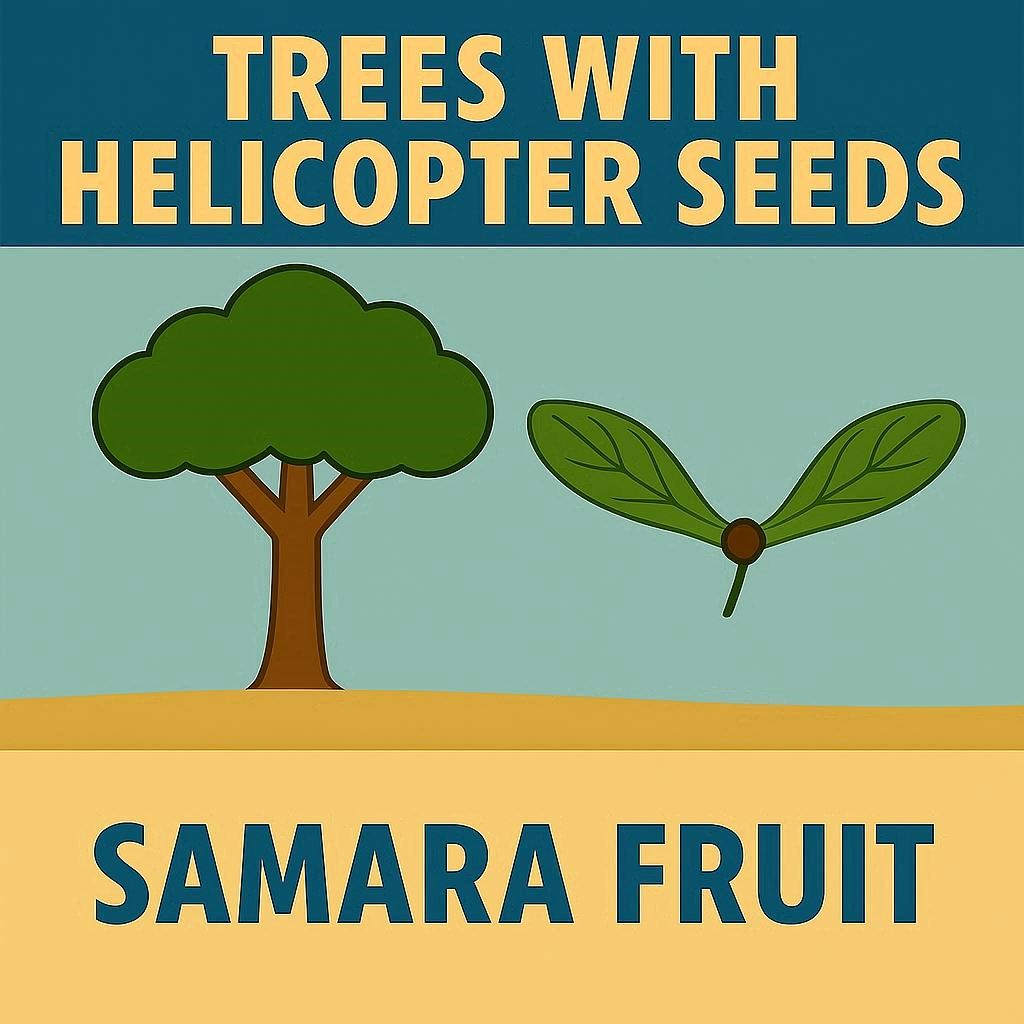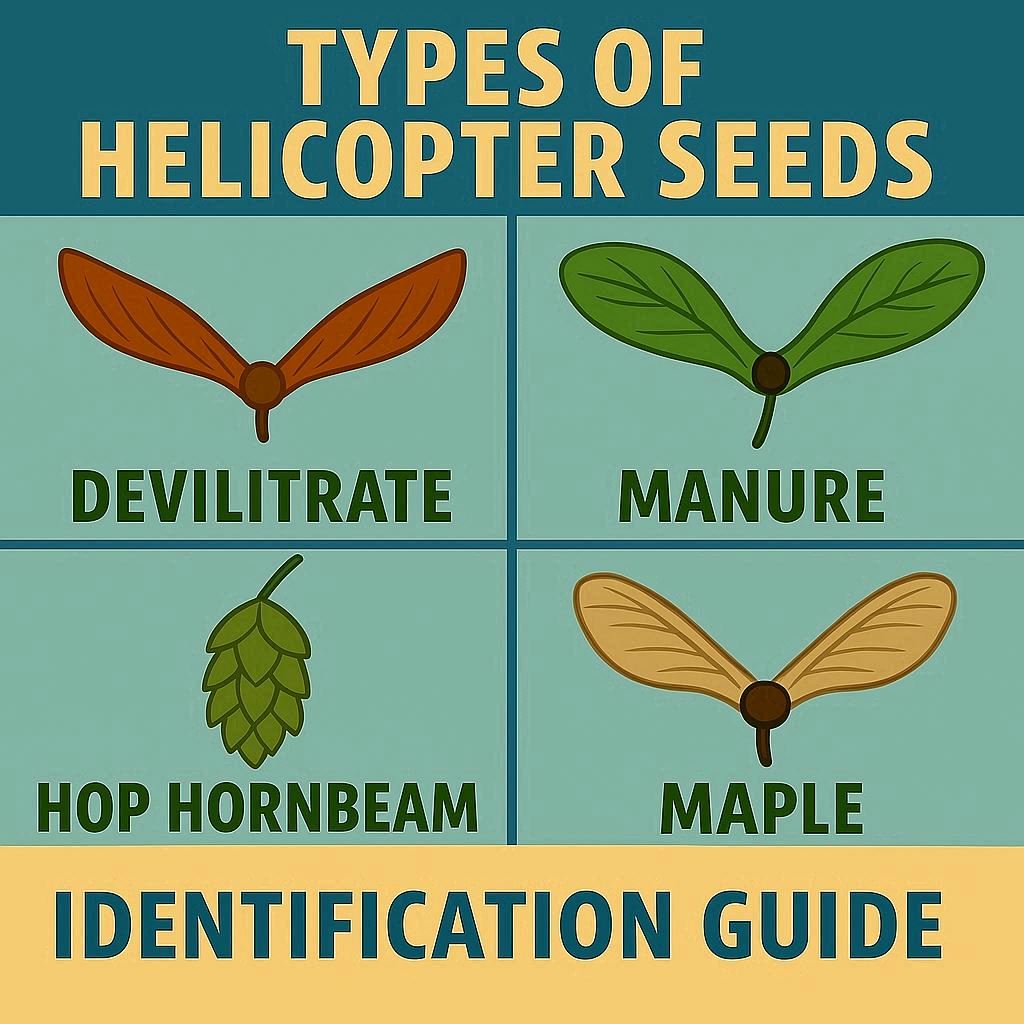
Helicopter seeds, scientifically known as samaras, represent one of nature’s most ingenious adaptations for seed dispersal. These winged fruits spin like helicopter rotors as they fall from trees, earning them popular nicknames such as “whirlybirds,” “spinning jennies,” “keys,” and “maple keys”. This spinning motion is not merely ornamental—it serves a crucial biological purpose by slowing the seed’s descent and allowing wind currents to carry them far from the parent tree, reducing competition and increasing the chances of successful germination in new locations.
The term “samara” refers specifically to a type of dry, indehiscent fruit featuring a flattened wing of papery or fibrous tissue extending from the seed. This evolutionary strategy, known as anemochory (wind dispersal), has been adopted by numerous tree species across different families, each developing unique variations in size, shape, and flight characteristics.
Whirlybirds, Helicopters, and Maple seeds
“Whirlybirds,” “helicopters,” and “maple seeds” all refer to the same thing: the winged seeds of a maple tree, also technically called samaras. They are given these names because their shape and spin make them resemble small flying machines as they fall from the tree, which helps them disperse far from the parent plant.
Samara: The technical term for the winged fruit, which is a specialized type of dry fruit designed for wind dispersal.
Helicopters/Whirlybirds: Common names given to maple seeds because of their spinning, helicopter-like flight pattern.
Mechanism: As the seed falls, the wing catches the air, creating a vortex that lowers air pressure above the seed and provides lift, allowing it to spin and stay airborne for a longer distance.
Other trees: While maple samaras are the most famous, other trees like ash and elm also produce similar winged seeds, though they are often single-winged.
🌳 What Are Helicopter Seeds?
Helicopter seeds (also known as samaras, whirlybirds, spinners, or polynoses) are a type of winged seed designed for wind dispersal. When they fall from a tree, their one- or two-winged shape makes them spin like miniature helicopters, slowing their descent and allowing the wind to carry them farther away.
This clever design helps trees colonize new areas and reduce competition between parent and offspring for sunlight, water, and nutrients.
🌬️ How Helicopter Seeds Work
The spinning motion of helicopter seeds is a result of aerodynamics. Each samara has a seed on one end and a lightweight wing on the other. As it falls, air pushes against the wing, creating lift. This lift causes the seed to spin in a spiral motion, slowing its fall and allowing it to drift away with even the gentlest breeze.
This natural engineering is so efficient that scientists have studied helicopter seeds to inspire drone and aircraft design, making these tiny seeds an example of bio-inspired engineering.
🍁 Trees That Produce Helicopter Seeds
Many trees produce samaras, but maples are the most famous for their spinning seeds. However, there are also other tree species that produce similar winged fruits. Below are the main types of helicopter seeds found in nature.
1) Maple Trees (Acer Species)
Maple trees are arguably the most recognizable producers of helicopter seeds, with their distinctive paired samaras joined at the seed and opening at various angles to form characteristic “V” shapes. These paired structures eventually split and fall separately, each spinning independently through the air.
Sugar Maple (Acer saccharum) produces classic paired samaras that begin green in spring and mature to a tan color by fall. These trees are economically important for maple syrup production and are distinguished by their five-lobed leaves with smooth edges.
Silver Maple (Acer saccharinum) generates the largest maple samaras, measuring up to 75mm in length. These seeds feature prominently veined, papery wings and are produced by trees known for their rapid growth rate of 2-3 feet per year.
Red Maple (Acer rubrum) creates medium-sized paired samaras that appear reddish in their early stages, complementing the tree’s reputation for brilliant red fall foliage. Red maples are among North America’s most widespread species and are valued for their adaptability to various soil conditions.
Norway Maple (Acer platanoides) produces wide, flat samaras that open at nearly 180 degrees, making them easily distinguishable from other maple species. These non-native trees are commonly planted in urban environments and parks.
Box Elder (Acer negundo) is extremely prolific in samara production, creating abundant paired seeds with a more closed angle than other maples. Despite being a maple species, box elder is often mistaken for other tree types due to its compound leaves.
2) Ash Trees (Fraxinus Species)
Ash trees produce single, elongated samaras with a distinctive paddle-like appearance, where the wing extends from one end of the seed. These seeds are often called “keys” and provide important winter food for birds and small mammals.
White Ash (Fraxinus americana) creates samaras measuring 1.25 to 2.25 inches long, with wings that are more pointed than those of green ash. The seeds are characterized by a shorter, stouter seed portion that takes up a smaller percentage of the total samara length.
Green Ash (Fraxinus pennsylvanica) produces longer, narrower samaras where the seed portion occupies a greater percentage of the total length. These trees are widely distributed across floodplains and riparian areas, though they face severe threats from the invasive emerald ash borer.
3) Elm Trees (Ulmus Species)
Elm trees generate distinctive single samaras where the seed is positioned at the center of a thin, papery, circular wing. This design creates a unique “flying saucer” appearance that differs significantly from the elongated samaras of other species.
Siberian Elm (Ulmus pumila) produces small, wafer-like samaras that are particularly abundant and are considered invasive in many regions. The tree’s prolific seed production contributes to its aggressive spreading behavior.
Winged Elm (Ulmus alata) creates reddish-green samaras with wings that completely encircle the seed, ripening and dispersing in April. This species is native to the southeastern United States and is distinguished by the corky wings that grow from its twigs.
4) Sycamore Maple (Acer pseudoplatanus)
The sycamore maple, often simply called sycamore in the UK, produces paired samaras that occasionally form clusters of three or four seeds. These samaras have a narrower V-shape compared to field maple and Norway maple, with wings measuring 20-40mm in length.
5) Tree of Heaven (Ailanthus altissima)
This invasive species produces unique twisted samaras that are single-winged and often tinged red or brown. Female trees are exceptionally prolific, capable of producing over 300,000 seeds annually. The twisted wing design creates an effective spinning motion that aids in long-distance wind dispersal.
6) Hoptree (Ptelea trifoliata)
Hoptree produces distinctive round, wafer-like samaras that are flat and papery, measuring about 1 inch in diameter. These two-seeded fruits resemble elm samaras but are perfectly circular and have been historically used as a substitute for hops in brewing.
7) Tulip Tree (Liriodendron tulipifera)
Tulip trees create small samaras that aggregate into cone-like clusters, with individual seeds measuring several inches in length when mature. These seeds are released gradually over several weeks, providing extended dispersal opportunities.
8) Mahogany Trees (Swietenia Species)
Mahogany trees produce large, single-winged samaras that flutter like paper airplanes as they descend. The seeds are flat and dark, ranging from blackish to brownish in color, and each fruit capsule can contain up to 71 winged seeds.
9) Birch Trees (Betula Species)
Birch trees generate tiny samaras with narrow wings that are released in clusters from catkins. These small, lightweight seeds drift easily on even the slightest breeze, allowing for effective local dispersal.
10) Alder Trees (Alnus Species)
Alder trees produce small, winged seeds contained within woody, cone-like structures called strobiles. The seeds have corky wings containing air bubbles, which allows them to float and be dispersed by water as well as wind.
Italian Alder (Alnus cordata) creates the largest fruiting cones in the Alnus genus, measuring 1 inch long and containing numerous winged seeds. The cones mature from green to dark brown and persist through winter before opening in spring.
Common Alder (Alnus glutinosa) produces brown, pentagonal, flattened nuts with rudimentary wings that are dispersed by both wind and water. These trees are particularly valuable ecologically, as their nitrogen-fixing ability enriches soil in wetland environments.

Identification Characteristics
Understanding the distinguishing features of different helicopter seeds aids in proper tree identification:
- Maple samaras: Always paired, joined at the seed, opening at various angles from narrow V-shapes to nearly 180 degrees
- Ash samaras: Single, elongated, paddle-shaped with the wing extending from one end
- Elm samaras: Single, circular, with the seed centered in the middle of the papery wing
- Hoptree samaras: Perfectly round, wafer-like, resembling potato chips
- Tree of Heaven samaras: Single, twisted wing with reddish coloration
- Tulip Tree samaras: Small, aggregated in cone-like clusters
- Mahogany samaras: Large, single-winged, fluttering descent pattern
- Birch samaras: Tiny, narrow-winged, released from catkins
- Alder samaras: Small, contained within woody, cone-like structures
4 Maple Trees That Produce The Most Helicopter Seeds
Certain maple species are notably prolific in producing “helicopter seeds,” or samaras, as part of their reproductive strategy. While nearly all maple trees create samaras, the number produced can vary greatly by species and environmental factors. Some maples may produce a very large crop, known as a mast year, followed by years with fewer seeds.
1. Norway maple (Acer platanoides)
As a highly adaptive and widely planted ornamental tree, the Norway maple is a particularly heavy seed producer. Each tree can produce vast quantities of paired samaras that are easily dispersed by wind, which contributes to this species being considered invasive in many parts of the United States. Its aggressive seeding and ability to thrive in many conditions mean a single tree can blanket an area with “helicopters” each spring.
2. Silver maple (Acer saccharinum)
The silver maple is a fast-growing, large shade tree common throughout eastern North America. It is well-known for its abundant production of samaras, which typically drop in the spring. Like other maples, the silver maple can have mast years where seed production is especially high, leading to the ground underneath and around the tree being covered in seeds. The paired, winged samaras are relatively large and have a characteristic V-shape.
3. Red maple (Acer rubrum)
Red maples are one of the most common and widespread native trees in eastern North America. They are prodigious seed producers, with the female flowers giving way to large clusters of reddish-tinged samaras. Red maples are often among the first trees to flower in the spring, releasing their “helicopters” shortly after. The sheer abundance of this species means that the collective seed output is enormous.
4. Bigleaf maple (Acer macrophyllum)
Known for its massive leaves—the largest of any maple—the bigleaf maple is a prolific seed producer native to the Pacific Northwest. These trees produce their seeds in pairs of large, hairy samaras with wings up to 2 inches long. The seeds ripen in the fall and are dispersed by wind, often remaining on the tree well into the winter. A single bigleaf maple can drop a significant number of “helicopters,” especially as it matures.
What influences seed production?
Even among these prolific species, not every tree will produce a heavy seed crop every year. Several factors influence the amount of samaras a tree will produce:
- Tree health: A healthy, mature tree with ample sunlight and nutrients will produce more seeds.
- Seed crop years: Maple trees often have “bumper crop” years where they produce an exceptionally large amount of seeds. This typically alternates with years of lighter production.
- Energy use: During heavy seed years, a maple tree may produce fewer leaves, as its energy is focused on seed development.
Ecological and Evolutionary Significance
The evolution of helicopter seeds represents a sophisticated solution to the fundamental challenge of seed dispersal. Trees that produce samaras typically grow taller than average, utilizing their height advantage to maximize wind exposure and dispersal distance. This strategy proves particularly effective for species that colonize disturbed areas or seek to establish new populations beyond the competitive radius of parent trees.
The spinning motion of samaras is created by the uneven weight distribution between the seed and wing, combined with the aerodynamic properties of the wing surface. This autorotation creates lift and drag forces that slow the descent while allowing horizontal movement with wind currents, effectively transforming a simple falling seed into a gliding aircraft.
Cultural and Human Uses
Beyond their biological importance, helicopter seeds hold cultural significance across many societies. Children worldwide have played with spinning maple seeds for generations, tossing them skyward and watching them spiral to the ground. Various cultures have developed unique names for these seeds, including “whirligigs,” “keys,” “spinners,” and “polynoses” in different regions.
Some helicopter seeds also have practical applications. Elm samaras are edible when young and tender, offering a cucumber-like flavor that can be consumed raw or cooked. Hoptree samaras have historically been used as a substitute for hops in beer brewing, while various species have found uses in traditional medicine and crafts.
Seasonal Patterns and Management
Most helicopter seed production occurs in spring and early summer, with different species releasing their seeds at various times throughout the growing season. Maple trees typically produce seeds annually, though the quantity can vary significantly based on weather conditions, tree health, and environmental factors.
For property owners dealing with abundant helicopter seeds, understanding these patterns helps in planning cleanup and management strategies. Seeds can accumulate in gutters, gardens, and lawns, potentially germinating into unwanted seedlings if left unmanaged. Regular collection during peak drop periods and prompt removal from planting areas can prevent establishment of volunteer trees.
Conservation and Environmental Impact
Many trees producing helicopter seeds face various environmental challenges. Ash species throughout North America are severely threatened by the invasive emerald ash borer, which has killed millions of trees and fundamentally altered forest ecosystems. Conversely, some helicopter seed producers like Tree of Heaven and Siberian Elm are themselves invasive species that can overwhelm native plant communities through their prolific seed production and aggressive growth habits.
Understanding the identification and characteristics of helicopter seeds becomes crucial for conservation efforts, invasive species management, and forest restoration projects. Native species like sugar maples, white ash, and various elm species require protection and propagation, while invasive producers need careful monitoring and control.
FAQs About Helicopter Seeds
1. Why are they called helicopter seeds?
Because their spinning motion as they fall resembles a helicopter rotor, allowing them to glide and travel through the air.
2. Do all maple trees have helicopter seeds?
Yes, all maple species produce samaras, but the size, shape, and timing vary depending on the species.
3. When do helicopter seeds fall?
The timing depends on the species:
- Spring: Silver Maple, Red Maple
- Late Summer/Fall: Sugar Maple, Norway Maple, Boxelder
4. Can I grow a maple tree from a helicopter seed?
Yes! Collect mature seeds, dry them, and stratify (chill) them for a few months before planting in spring.
5. Are helicopter seeds harmful to lawns or gardens?
No, they’re harmless. However, if not cleaned up, they can sprout into unwanted seedlings.
6. Which maple tree produces the most helicopter seeds?
The Silver Maple and Norway Maple are known to produce the largest and most abundant helicopter seeds.
7. What’s the difference between helicopter seeds and regular seeds?
Helicopter seeds have a wing-like structure that allows wind dispersal, while regular seeds usually fall straight down or rely on animals for spreading.
8. Can animals eat helicopter seeds?
Yes, squirrels, birds, and small mammals often eat the seeds inside samaras, especially during fall and winter.
🌳 Final Thoughts
Helicopter seeds are more than just a childhood curiosity — they’re a masterpiece of nature’s design. Whether from maples, ashes, elms, or tulip trees, these spinning samaras play a crucial role in sustaining forests by spreading life across the landscape.
Next time you see those little “helicopters” swirling through the air, take a moment to appreciate the genius of evolution — a perfect blend of form, function, and flight.
Citations
